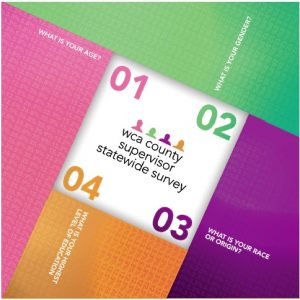WCA County Officials Statewide Survey

A popular piece of advice for speakers, businesses, and others is some form of “know your __,” whether it is ‘audience,’ ‘customer,’ or something else. In 2016 and again this year, the Wisconsin Counties Association (WCA) took that advice to heart. While WCA staff spend significant time getting to know members personally, the association felt a statistical snapshot of county board supervisors could be useful to both WCA, as well as its members.
To that end, WCA surveyed 1,600 county board supervisors this past spring and received 1,100 responses. The response rate of 68.8% was well above the average 30% to 40% rate that is typical for a survey like this.
The first part of the survey asked about supervisor characteristics: age, gender, education, work status, residency, and county board tenure, and is the focus of this article. The second part dealt with member interaction with WCA staff, events, social media, educational opportunities, and publications.
Characteristics of Supervisors
County supervisors are generally older, more likely to be male, and better educated than those they represent. If they are working, they are more likely to be self-employed.
Age & GenderA 2013 national survey from the Bipartisan Policy Center (BPC) found that 14% of those 18-to-29 years of age were very interested in serving in public office. That percentage was significantly lower for those 30-44 (6%), or 65 or older (3%), and slightly lower for those 45-64 (12%).
Thus, it might be surprising that over half of all county supervisors are 65 or older (see Figure 1). Another quarter are 55 to 64 years of age.
Those percentages differ from Wisconsin’s adult population of which 21.2% are 65 or older and 18.1% are 55 to 64. Less than 10% of supervisors are under 45 years of age, compared to nearly 44% of Wisconsin adults.
The median age (half younger, half older) of board members is 66. By comparison, the average state senator is 59 years of age and the average representative is 51. Among all state residents 18 or older, the average age is 48.
The BPC survey also found that 14% of men were very interested in running for office, compared to just 5% of women. That may partially explain why nearly 80% of county board members are male and only 20.5% are female (see Figure 2). While skewed heavily male, the gender mix is not much different from the state legislature. In 2018, 76% of legislators were male and 24% were female.
The county board percentages for 2018 mirror those from 2016, though there are indications that over time, the male-female gap may slowly shrink. Among board members 45 or older, less than 20% are women. That percentage rises to over 28% for those 35 to 44 years of age and to 36% for those under 35. Moreover, 28% of new supervisors in 2016 and 25% in 2018 were women. More female supervisors, particularly younger ones, could motivate other women to run for county board.


Work Status, Education, & Tenure
Given the age profile of board members, it is not surprising that many are retired. Of the 1,082 people who responded to this question, 52.9% said they are retired (see Figure 3). Another 51.8% were employed, with just under half of them self-employed. The share of workers who are self-employed is unusual. Among all workers in Wisconsin, only 10% are self-employed.
Less than 5% of respondents reported they were a student, unemployed, or “other.” The percentages on this question add to more than 100% since respondents were allowed to check more than one box (e.g., a retiree who works part-time could check both “retired” and “employed outside the home.”)
County supervisors are generally well educated. While 26.1% of Wisconsin adults have a bachelor’s degree or more, 45.6% of county board members have that level of education (see Figure 4). Another 37.5% of supervisors have some post-secondary education, compared to 33.2% of adults in the state.
However, education differs by gender and by age. While 25.2% of male supervisors have a bachelor’s degree, 30.8% of female board members have such a degree. For post-graduate degrees, the gender gap widens: 29.9% of women have a post-graduate degree compared to just 16.6% of men.
As might be expected, supervisors under 45 years of age (Figure 5, gold bars) are more likely to have some education post high school compared to those older. Among the younger group, 94.2% have some post-secondary education compared to 83.7% of those 45 to 64 and 80.8% of those 65 or older.
Much of that gap is at the bachelor’s degree level. Among the younger cohort, about 40% have bachelor’s degrees. That compares to about 25% among the two older groups.




